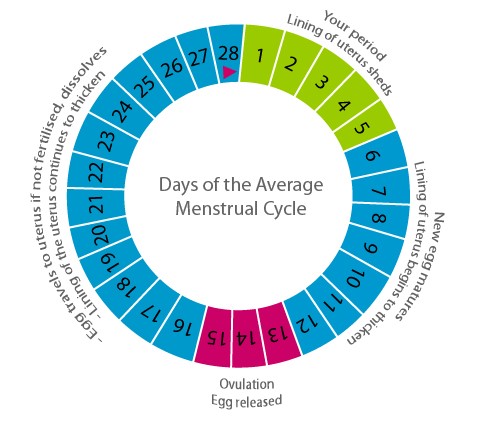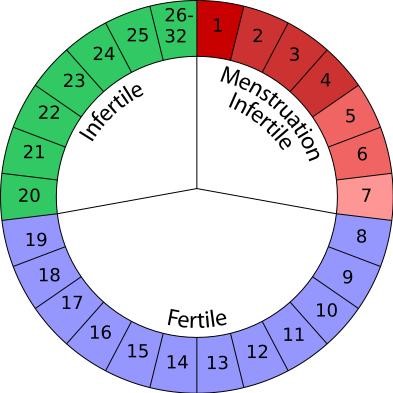For most women, the average menstrual cycle is every 28 days. However, cycles can be shorter or longer, such as anywhere between 24 and 35 days, and those are considered normal as well. Learning how to calculate menstrual cycle is something that most women will find very handy as they go through life—after all, the average woman will experience about 480 periods in their lifetime. It would be great to know when to expect those to happen!
How to Calculate Menstrual Cycle
Learning how to calculate your menstrual cycle is much easier than you might think, but it does take some time. To be sure that you are correct about your cycle, you will have to track it for several months to make sure your predictions about your next period are accurate. Here’s how to start.
- When you begin your period, write down the date.
- Keep track of how many days the period lasts.
- When you begin your period the next month, make note of that date.
- Count the days between your period start dates.
- Now count forward from the beginning of your second period to the appropriate number of days – this should be when you start your period again.
You can also keep track of any symptoms you might have, such as bloating, feeling irritable, being more tired than usual, and the like. These are signs of premenstrual syndrome, or PMS, a condition that many women suffer from during the course of their menstrual cycle. The symptoms tend to get much worse right before the period begins.
What Happens in Each Menstrual Cycle?
Why should you care about how to calculate menstrual cycle? It matters for many reasons. Some women just want to know when to expect the monthly flow. Others are trying to get pregnant and want to be able to track their ovulation times—this begins by learning to track periods. Others just want to make sure everything is okay each month.
A menstrual cycle is much more than just a period. There are actually three very distinct phases throughout the month that create the full cycle.

Day 1 to 12: The Follicular Phase
This begins on the day you begin to bleed and continues until the day you ovulate. Certain hormones course through the body and prepare the ovaries to release follicles. One of those follicles will grow rapidly and turn into the ovum – or the egg that is released during the ovulatory phase. The follicle secretes estrogen, and that helps build up the lining of the uterus.
Day 13 to 15: The Ovulatory Phase
In this phase, the egg is released into the fallopian tube. Once it is released, there is a 24-48 hour window during which it could be fertilized by male sperm. Cervical mucus increases during this time, to help the sperm swim up to the egg. If the egg is not fertilized, the lining begins to break down and the next phase begins.
Day 16 to 28: The Luteal Phase
During this phase, the body is still preparing to get pregnant at first, releasing the proper hormones and waiting for fertilization. When it doesn’t happen, the body begins to break down the uterine lining. This leads to having your period – your period is actually your body shedding the uterine lining that was prepared for pregnancy but never used.
Make Use of PMS Symptoms to Know When Your Period Starts
As mentioned earlier, using the signs of PMS as a good indicator of how to calculate menstrual cycle has been used by women all over the world for centuries. The signs can vary from one woman to another; for some, they are quite mild or non-existent, while others might experience every single one of them with intensity severe enough to interfere with daily life.
The emotional and mental symptoms of PMS might include:
- Tension, anxiety, depression and crying spells
- Cravings for certain foods or sudden food aversions
- Insomnia or restless sleep
- Irritability, mood swings or anger for no apparent reason
- Withdrawing from loved ones
- Finding it hard to concentrate or focus
Physical symptoms of PMS can include:
- Abdominal bloating and temporary weight gain
- Headaches and pain in the joints or muscles
- Constipation or diarrhea
- Feeling tired all the time
- Mild to severe breast tenderness and tingling
- Flare-ups of acne, if you are prone to that problem
Keep in mind that PMS symptoms typically ramp up in the days right before your period. This can help you be certain that you are correct when learning how to calculate menstrual cycle, but remember that PMS is not a guaranteed point: some women will have symptoms one month and then no symptoms the next.
What Is Fertility Awareness?
A woman who wants to get pregnant might turn to the Fertility Awareness Method to further calculate her menstrual cycle. This works by learning how to monitor and measure your body changes throughout the phases of the cycle. For instance, charting the cycle can help pinpoint a few days when ovulation is most likely.
In order to make this work, a woman must be able to track her periods accurately. To avoid pregnancy, use a barrier method during the most fertile time, or abstain altogether. To try getting pregnant, make a point of having sex often during the 48 hour window of ovulation. The fertile time – or the “unsafe days” for those who do not want to get pregnant – will encompass about one-third of her cycle.

How Fertility Awareness Works
This is a very simple method that requires a woman to pay close attention to her body. Some women might not like it because it means less spontaneity, especially for those who want to avoid pregnancy. But for those who do want to get pregnant, it can serve as a great way to increase the odds of making it happen. Keep in mind that this only works well if a woman’s cycle is very regular – yet another reason to learn how to calculate menstrual cycle as accurately as possible.
